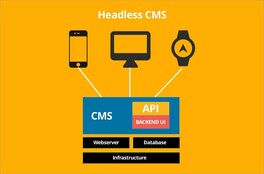
The term “headless” comes from the concept of chopping the “head” which is the front end, i.e. the web site off the “body” (the back end, i.e. the content repository).
Whereas a traditional CMS typically combines the content and presentation layers of a web site, a headless CMS is just the content component which focuses entirely on the administrative interface for content creators, the facilitation of content workflows and collaboration, and the organization of content into taxonomies.
It doesn’t include presentation layers, templates, site structure, or design, but rather stores its content in pure format and provides access to other components (e.g. delivery front ends, analytics tools, etc.) through stateless or loosely coupled APIs.
The headless CMS concept is one born of the demands of the digital era and a business’s need to focus on engaging customers with personalized content via multiple channels at all stages of the customer journey. As the content in a headless CMS is considered “pure” (because it has no presentation layer attached) just one instance of it can be used for display on any device; web site, mobile, tablet, smart watches, etc.
There is some confusion around what makes a headless CMS truly “headless”, as vendors use the term somewhat loosely to label their decoupled or hybrid CMS systems. But a true headless CMS is one that was built from the ground up to be API-first, not a full monolith CMS with APIs attached afterwards.
Cloud-first headless CMSs are those that were also built with a multi-tenant cloud model at their core and whose vendor promotes Software as a Service (Saas), promising high availability, scalability, and full management of security, upgrades, and hot fixes, etc. on behalf of clients.
Coupled CMS vs. Headless CMS
Most traditional (monolithic) CMS systems are “coupled”, meaning that the content management application (CMA) and the content delivery application (CDA) come together in a single application, making back-end user tools, content editing and taxonomy, web site design, and templates inseparable.
Coupled systems are useful for blogs and basic web sites as everything can be managed in one place. But this means that the CMS code is tightly connected to any custom code and templates, which means developers have to spend more time on installations, customization, upgrades, hot fixes, etc. and they cannot easily move their code to another CMS.
There is a lot of confusion around the differences between a decoupled CMS and a headless one because they have a lot in common.
A decoupled CMS separates the CMA and CDA environments, typically with content being created behind the firewall and then being synchronized and pushed to the delivery environment.
The main difference between a decoupled CMS and a headless CMS is that the decoupled architecture is active. It prepares content for presentation and then pushes it into the delivery environment, whereas a headless CMS is reactive. It sits idly until a request is sent for content.
Decoupled architecture allows for easier scalability and provides better security than coupled architecture, but it does not provide the same support for omni-channel delivery. Plus, there are multiple environments to manage, this increasing infrastructure and maintenance costs.
Advantages of Headless CMS
- Omnichannel readiness: the content created in a headless CMS is “pure” and can be re-purposed across multiple channels, including web site, mobile applications, digital assistant, virtual reality, smart watches, etc., in other words, anywhere and at any time through the customer journey.
- Low operating costs: headless CMSs are usually cheaper to install and run than their monolith counterparts, especially as they are typically built on a cloud model where multi-tenant options keep the running costs low.
- Reduces time to market: a headless CMS promotes an agile way of working because content creators and developers can work simultaneously, and projects can be finished faster.
- Easy to use: traditional CMSs tend to be cumbersome and complex as vendors attempt to offer every available feature in one box. Headless systems focus on content management, keeping things simple for those who use it on a daily basis. The entire user experience can usually be managed from within one back end.
- Flexibility: content editors can work in whichever headless CMS they like and developers can build any kind of front end they want in their preferred language (e.g. Ruby, PHP, Java, or Swift) and then simply integrate the two via APIs (like JSON or XML) over RESTful communication. This allows for polyglot programming where multiple programming paradigms can be used to deliver content to multiple channels, and enables a company to benefit from the latest developments in language frameworks, promoting a micro-services architecture.
- Cloud Scalability: the content purity and stateless APIs of headless CMSs enable high scalability, especially as the architecture fully leverages the elasticity of a cloud platform.
- System Security: since the content is typically provided through a high-performance Content Delivery Network (rather than directly from the database), the risk of distributed denial-of-service attacks (DDOS) is reduced.
- Marketing empowerment: marketers may end up relying more on developers in certain scenarios, e.g. creating a landing page with custom layout.
- Multiple services: managing multiple systems can be challenging and a team’s knowledge base must cover them all.
- No channel-specific support: since pure headless CMSs don’t deal with the presentation layer, developers may have to create some functionality, such as web site navigation.
- Content organization: as pure headless CMSs do not typically provide the concept of pages and web site maps, content editors need to adapt to the fact that content is organized in its pure form, independently on the web site or other channel.
In the following posts, we will look more into headless CMS and will describe specific headless CMS. Stay tuned.
 RSS Feed
RSS Feed
